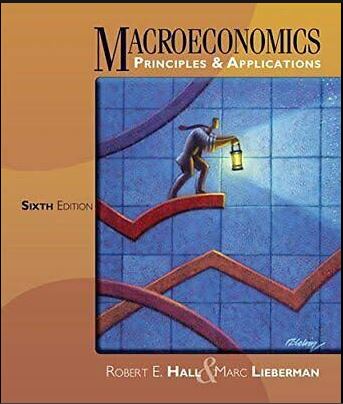
Microeconomics 6th Edition by Robert Hall, Shirley Kuiper, Marc Lieberman
Edition 6ISBN: 978-1133708735
Microeconomics 6th Edition by Robert Hall, Shirley Kuiper, Marc Lieberman
Edition 6ISBN: 978-1133708735 Exercise 6
In a certain large city,hot dog vendors are perfectly competitive,and face a market price of $1 per hot dog. Each hot dog vendor has the following total cost schedule:
 a. Add a marginal cost column to the right of the total cost column. (Hint: Don't forget to divide by the change in quantity when calculating MC.)b. What is the profit-maximizing quantity of hot dogs for the typical vendor,and what profit (loss)will he earn (suffer)? Give your answer to the nearest 25 hot dogs.
a. Add a marginal cost column to the right of the total cost column. (Hint: Don't forget to divide by the change in quantity when calculating MC.)b. What is the profit-maximizing quantity of hot dogs for the typical vendor,and what profit (loss)will he earn (suffer)? Give your answer to the nearest 25 hot dogs.
One day,Zeke,a typical vendor,figures out that if he were the only seller in town,he would no longer have to sell his hot dogs at the market price of $1. Instead,he'd face the following demand schedule:
 c. Add total revenue and marginal revenue columns to the table above. (Hint: Once again,don't forget to divide by the change in quantity when calculating MR.)d. As a monopolist with the cost schedule given in the first table,how many hot dogs would Zeke choose to sell each day? What price would he charge?
c. Add total revenue and marginal revenue columns to the table above. (Hint: Once again,don't forget to divide by the change in quantity when calculating MR.)d. As a monopolist with the cost schedule given in the first table,how many hot dogs would Zeke choose to sell each day? What price would he charge?
e. A lobbyist has approached Zeke,proposing to form a new organization called "Citizens to Eliminate Chaos in Hot Dog Sales." The organization will lobby the city council to grant Zeke the only hot dog license in town,and it is guaranteed to succeed. The only problem is,the lobbyist is asking for a payment that amounts to $200 per business day as long as Zeke stays in business.
On purely economic grounds,should Zeke go for it? (Hint: If you're stumped,re-read the section on rent-seeking activity.)
 a. Add a marginal cost column to the right of the total cost column. (Hint: Don't forget to divide by the change in quantity when calculating MC.)b. What is the profit-maximizing quantity of hot dogs for the typical vendor,and what profit (loss)will he earn (suffer)? Give your answer to the nearest 25 hot dogs.
a. Add a marginal cost column to the right of the total cost column. (Hint: Don't forget to divide by the change in quantity when calculating MC.)b. What is the profit-maximizing quantity of hot dogs for the typical vendor,and what profit (loss)will he earn (suffer)? Give your answer to the nearest 25 hot dogs.One day,Zeke,a typical vendor,figures out that if he were the only seller in town,he would no longer have to sell his hot dogs at the market price of $1. Instead,he'd face the following demand schedule:
 c. Add total revenue and marginal revenue columns to the table above. (Hint: Once again,don't forget to divide by the change in quantity when calculating MR.)d. As a monopolist with the cost schedule given in the first table,how many hot dogs would Zeke choose to sell each day? What price would he charge?
c. Add total revenue and marginal revenue columns to the table above. (Hint: Once again,don't forget to divide by the change in quantity when calculating MR.)d. As a monopolist with the cost schedule given in the first table,how many hot dogs would Zeke choose to sell each day? What price would he charge?e. A lobbyist has approached Zeke,proposing to form a new organization called "Citizens to Eliminate Chaos in Hot Dog Sales." The organization will lobby the city council to grant Zeke the only hot dog license in town,and it is guaranteed to succeed. The only problem is,the lobbyist is asking for a payment that amounts to $200 per business day as long as Zeke stays in business.
On purely economic grounds,should Zeke go for it? (Hint: If you're stumped,re-read the section on rent-seeking activity.)
Explanation
The data related to marginal cost,margin...
Microeconomics 6th Edition by Robert Hall, Shirley Kuiper, Marc Lieberman
Why don’t you like this exercise?
Other Minimum 8 character and maximum 255 character
Character 255


